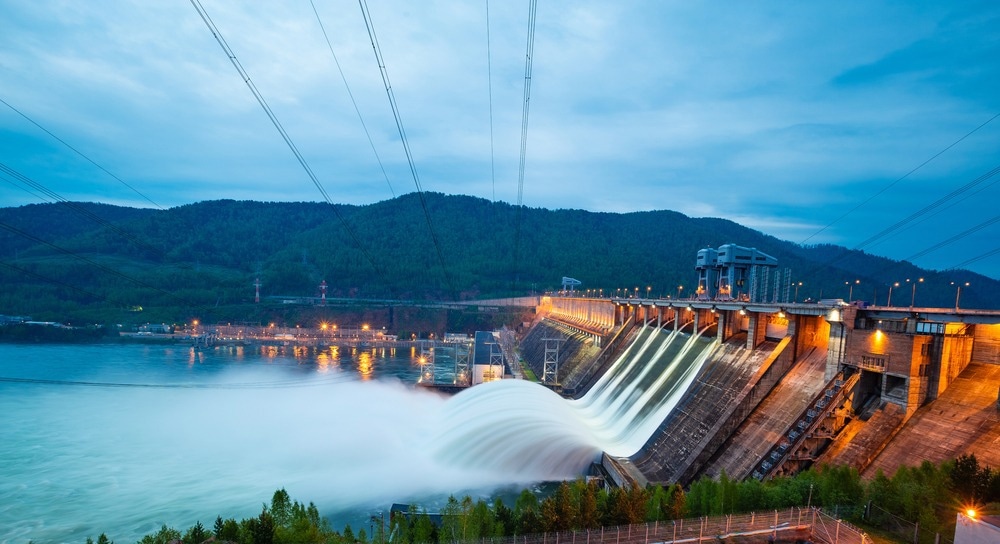Southwest Research Institute introduces the m-Presa™ modular steel buttress dam system, aimed at addressing energy storage challenges impeding incorporating renewable resources into the energy mix.

Image Credit: Evgeny_V/Shutterstock.com
This innovative system expedites the creation of paired reservoirs for grid-scale energy storage and generation through closed-loop pumped storage hydropower (PSH). It slashes dam construction expenses by a third and shortens construction timelines by half. The m-Presa system will be featured at booth 313 during the Clean Currents Conference in Cincinnati, running from October 10-13.
In electric power systems, PSH is employed for load balancing. This technique harnesses the gravitational potential energy of water, transferring it from a lower-elevation to a higher-elevation reservoir by utilizing cost-effective, surplus off-peak electric power to drive the pumps.
In times of elevated electrical demand, the stored water is released back to the lower reservoir, propelling turbines to generate electric power. While the pumping process incurs some energy losses, it consumes more energy than it produces.
However, the system adds value by delivering additional electricity during peak demand periods, when electricity prices are at their highest. This helps mitigate the challenges linked to the substantial daily fluctuations in intermittent, variable, and carbon-free renewable energy sources like solar and wind power.
Pumped storage hydropower accounts for approximately 95 percent of all energy storage in the U.S., and modern PSH plants have a round-trip efficiency approaching 80%. However, only one moderate-sized 40 MW PSH plant has been constructed in the past two decades in the U.S. Three factors stand in the way of rapidly deploying PSH: cost to construct, time to construct, and potential environmental impacts. The SwRI-developed m-Presa system addresses all three of these issues.
Dr. Gordon Wittmeyer, Hydrologist, Chemistry and Chemical Engineering Division, Southwest Research Institute
The obstacles that persistently discourage fresh investments in PSH encompass substantial capital expenditures, which can amount to as high as $5,000 per kW of installed capacity, and the absence of transparent pricing signals for energy storage. The innovative m-Presa™ design has the potential to trim construction expenses down to $1,500 per kW of installed capacity, rendering PSH a competitive option alongside other long-term energy storage methods.
The time to construct reservoirs is a significant cost component as well. It often takes 10 years to site, design, construct, and commission a conventional PSH plant at a time when private investors are realizing paybacks of 10 years or less from subsidized solar and wind farms. Reducing the time between project initiation and revenue generation could make PSH more attractive than other solutions used to manage huge daily swings in solar generation, such as non-sustainable gas peaking plants or shorter-lived battery energy storage systems.
We propose closed-loop pumped storage hydropower units by storing water in upper and lower reservoirs, impounded by buttress dams constructed from prefabricated structural steel modules. These structural steel modules can be transported on standard-sized flatbed trailers to allow rapid modular construction of 10- to 40-foot-high buttress dams that can enclose a wide range of surface areas and water volumes.
Dr. Gordon Wittmeyer, Hydrologist, Chemistry and Chemical Engineering Division, Southwest Research Institute
Environmental concerns regarding the construction of reservoirs pose a substantial hindrance to the widespread adoption of PSH, particularly when it involves impounding a natural waterway. However, the potential environmental impacts connected to closed-loop PSH can be mitigated or entirely averted by establishing upper and lower reservoirs through the construction of fully enclosed dams that are independent of natural streams or rivers.
The m-Presa system uses strong, long-lived steel buttress dams to create water impoundments that can store hundreds to thousands of MWhs of energy to supply power during periods of peak demand and provide ancillary services for grid stability. A PSH unit using the m-Presa system can be constructed in less than half the time needed for traditional PSH units that use earthen embankment or concrete dams to impound water.
Dr. Gordon Wittmeyer, Hydrologist, Chemistry and Chemical Engineering Division, Southwest Research Institute